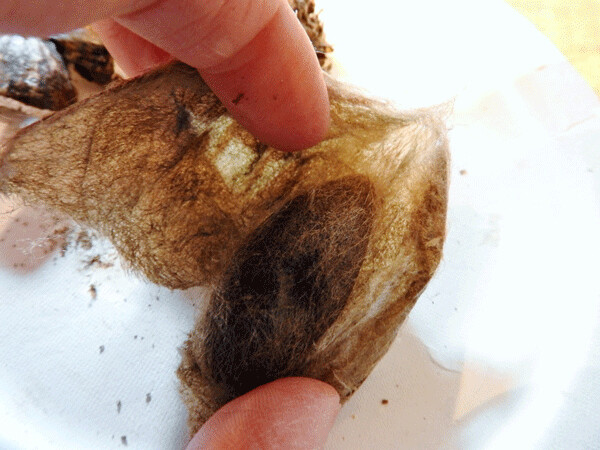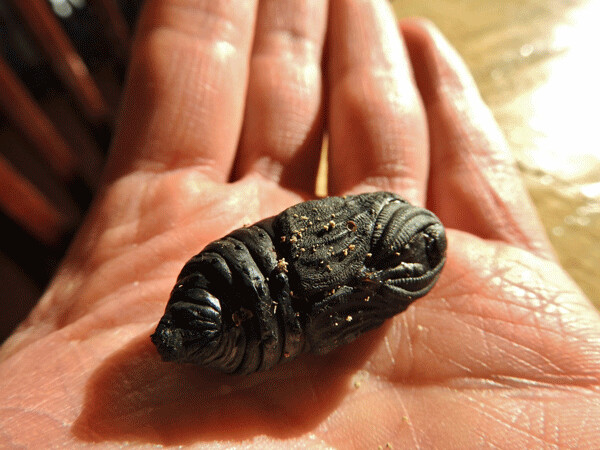News & Articles
Browse all content by date.

Laura Berlage had just impressed the students by showing them North Star Homestead Farm’s furry Kunekune pigs—a heritage breed from New Zealand that were made famous by their appearance in “The Hobbit.” Just beyond the barnyard we found another curiosity—and this one was a native!
I was looking for goldenrod galls, but what caught my eye was a cocoon attached to a maple stem near the trail. I tromped over in my snowshoes to get a better look. The students—part of an environmental psychology class from Luther College in Decorah, Iowa, looked on. (I think I had stunned them into silence earlier with my exuberance over finding weasel tracks by the wetland.)
Back in graduate school, I had the good fortune to spend a week studying winter ecology with author and ecologist Bernd Heinrich at his cabin in Maine. Between him and my tree-climbing friend Teage, our class collected and dissected over 20 cocoons belonging to Promethea moths. All of the pupae had been parasitized, mostly by ichneumon wasps.



This cocoon didn’t quite look like I remembered, though. When the larva of a Promethea moth is ready to pupate, it finds a leaf and sews the stem more securely onto the twig so that the tree’s own system for being deciduous is overridden. Then the pupa wraps itself up in the leaf and spins a cocoon inside. This is reasonably good camouflage, but we (and probably other critters, too) found it very easy to recognize the “last-leaf-hanging” for what it was.
In contrast, the cocoon at the Homestead did not incorporate a leaf. (One was dangling nearby, but was not incorporated into the cocoon.) And, instead of attaching to the twig by a single point, the length of one entire side was glued firmly along the stem. Carefully, and with more effort than I expected, I peeled the cocoon off its twig. It felt crisp on the outside, with plenty of airspace, but I could also feel something solid and hefty in the middle.
After a mile-long loop along the fields and through the old sugar bush, we tromped in to the Farmstead Café and Creamery for lunch. Up in Laura’s new fiber loft, I pulled the cocoon out of my pocket and began to separate the layers. The outer shell was tough. Woven of gray-brown silk, it was paper-thin but fabric-strong.
Like Russian dolls, I found a smaller cocoon inside. It was dark brown and suspended within the outer shell by a network of fuzzy silk. This one, too, I tore open gently. Inside, the thumb-sized, black pupa looked like something you’d find in an Egyptian tomb. A pattern of ridges cloaked its head like King Tut’s famous headdress. It was firm, and seemed healthy and unparasitized. After exclaiming in excitement, I passed the pupa and cocoon around the table. As the pupa warmed up, one student noticed it wiggle just a tiny bit.
While I couldn’t put a name on this creature right then, it didn’t take long when I got Google involved. From photos, I surmised that this mummy-like pupa would someday become a cecropia moth. Author and insect expert Charley Eismen later confirmed this identification through the BugGuide.net website, explaining that: “Cecropia moths attach their cocoons to twigs along their whole length; the other species you mentioned do not.”
On a website devoted to raising cecropia moths from eggs, I discovered that you can tell from the shape of the pupa if the developing moth inside is male or female—and the King Tut-like headdress is the key! The moth’s antennae create the patterned ridges in the pupal case. Males have huge antennae, whereas the antennae of females are more modest. We’d found a girl.
Come spring (when I take it out of my refrigerator), this pupa will wake up and continue its development into an adult moth. Upon exiting the cocoon (through a silk pathway woven cleverly by the caterpillar), this beautiful brown-winged, orange-lined, and white-spotted female will begin wafting pheromones on the breeze. A male, with his giant, brush-like antennae, will sweep the air for her alluring scent and detect it from up to three miles away, even if is diluted to only a few molecules in the air. By flying upwind toward a higher concentration of pheromones, he’ll eventually find her. After they mate, she’ll lay about one hundred eggs. Not having a gut or working mouthparts, both adults will die within a few days to a couple weeks.
The caterpillars that hatch from those eggs start out looking tiny, black, and bristly, and end up being four inches long with lime green skin and a rainbow of bristles. They eat a variety of tree leaves. At the end of summer, a caterpillar will choose a stick and start to spin its cocoon. Outer shell first, then the inner, and finally the caterpillar sheds its exoskeleton to become the pupa. I found that exoskeleton in a crumpled ball inside the inner cocoon. The “face” of the caterpillar was still recognizable!
The double-wall construction of the cocoon doesn’t prevent the larva from feeling the freezing weather, but the barrier does insulate it from abrupt temperature fluctuations, as well as potential predators. Birds, squirrels, bats, and owls will eat the larvae and adults. Parasitic wasps may destroy the pupae. One of the biggest problems for cecropia moths, and many of their friends, though, is pesticide use and habitat loss. Happily, the sustainable agriculture practiced on the North Star Homestead Farm allows for this and other natural neighbors to thrive.
For 50 years, the Cable Natural History Museum has served to connect you to the Northwoods. Come visit us in Cable, WI! Our new exhibit: “Better Together--Celebrating a Natural Community” is now open!
| Tweet |


